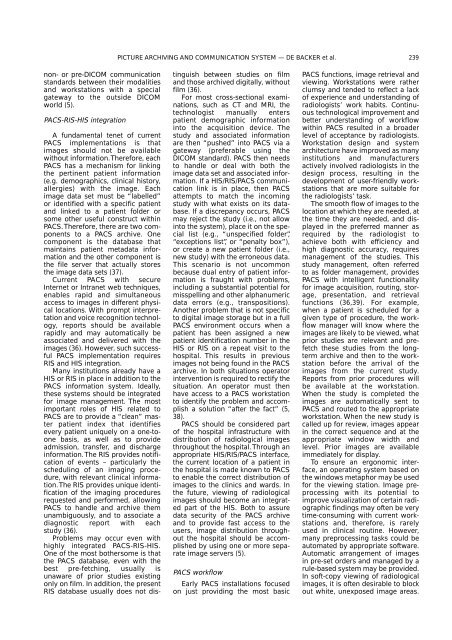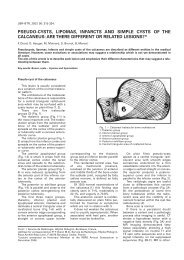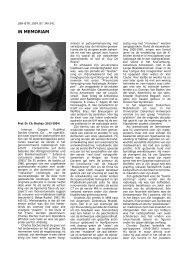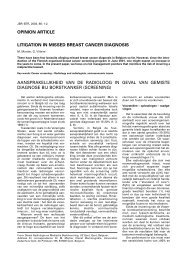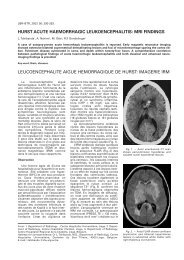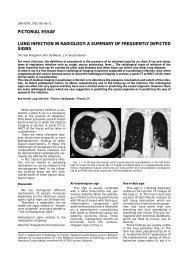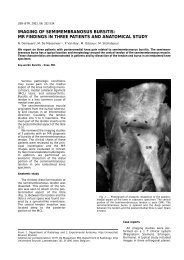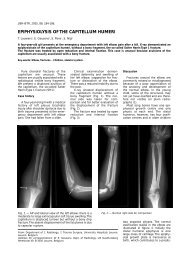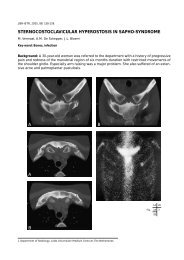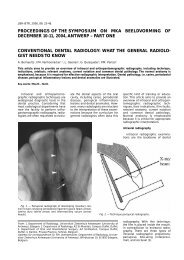review article picture archiving and communication system - rbrs
review article picture archiving and communication system - rbrs
review article picture archiving and communication system - rbrs
Create successful ePaper yourself
Turn your PDF publications into a flip-book with our unique Google optimized e-Paper software.
non- or pre-DICOM <strong>communication</strong><br />
st<strong>and</strong>ards between their modalities<br />
<strong>and</strong> workstations with a special<br />
gateway to the outside DICOM<br />
world (5).<br />
PACS-RIS-HIS integration<br />
A fundamental tenet of current<br />
PACS implementations is that<br />
images should not be available<br />
without information. Therefore, each<br />
PACS has a mechanism for linking<br />
the pertinent patient information<br />
(e.g. demographics, clinical history,<br />
allergies) with the image. Each<br />
image data set must be “labelled”<br />
or identified with a specific patient<br />
<strong>and</strong> linked to a patient folder or<br />
some other useful construct within<br />
PACS. Therefore, there are two components<br />
to a PACS archive. One<br />
component is the database that<br />
maintains patient metadata information<br />
<strong>and</strong> the other component is<br />
the file server that actually stores<br />
the image data sets (37).<br />
Current PACS with secure<br />
Internet or Intranet web techniques,<br />
enables rapid <strong>and</strong> simultaneous<br />
access to images in different physical<br />
locations. With prompt interpretation<br />
<strong>and</strong> voice recognition technology,<br />
reports should be available<br />
rapidly <strong>and</strong> may automatically be<br />
associated <strong>and</strong> delivered with the<br />
images (36). However, such successful<br />
PACS implementation requires<br />
RIS <strong>and</strong> HIS integration.<br />
Many institutions already have a<br />
HIS or RIS in place in addition to the<br />
PACS information <strong>system</strong>. Ideally,<br />
these <strong>system</strong>s should be integrated<br />
for image management. The most<br />
important roles of HIS related to<br />
PACS are to provide a “clean” master<br />
patient index that identifies<br />
every patient uniquely on a one-toone<br />
basis, as well as to provide<br />
admission, transfer, <strong>and</strong> discharge<br />
information. The RIS provides notification<br />
of events – particularly the<br />
scheduling of an imaging procedure,<br />
with relevant clinical information.<br />
The RIS provides unique identification<br />
of the imaging procedures<br />
requested <strong>and</strong> performed, allowing<br />
PACS to h<strong>and</strong>le <strong>and</strong> archive them<br />
unambiguously, <strong>and</strong> to associate a<br />
diagnostic report with each<br />
study (36).<br />
Problems may occur even with<br />
highly integrated PACS-RIS-HIS.<br />
One of the most bothersome is that<br />
the PACS database, even with the<br />
best pre-fetching, usually is<br />
unaware of prior studies existing<br />
only on film. In addition, the present<br />
RIS database usually does not dis-<br />
PICTURE ARCHIVING AND COMMUNICATION SYSTEM — DE BACKER et al. 239<br />
tinguish between studies on film<br />
<strong>and</strong> those archived digitally, without<br />
film (36).<br />
For most cross-sectional examinations,<br />
such as CT <strong>and</strong> MRI, the<br />
technologist manually enters<br />
patient demographic information<br />
into the acquisition device. The<br />
study <strong>and</strong> associated information<br />
are then “pushed” into PACS via a<br />
gateway (preferable using the<br />
DICOM st<strong>and</strong>ard). PACS then needs<br />
to h<strong>and</strong>le or deal with both the<br />
image data set <strong>and</strong> associated information.<br />
If a HIS/RIS/PACS <strong>communication</strong><br />
link is in place, then PACS<br />
attempts to match the incoming<br />
study with what exists on its database.<br />
If a discrepancy occurs, PACS<br />
may reject the study (i.e., not allow<br />
into the <strong>system</strong>), place it on the special<br />
list (e.g., “unspecified folder”,<br />
“exceptions list”, or “penalty box”),<br />
or create a new patient folder (i.e.,<br />
new study) with the erroneous data.<br />
This scenario is not uncommon<br />
because dual entry of patient information<br />
is fraught with problems,<br />
including a substantial potential for<br />
misspelling <strong>and</strong> other alphanumeric<br />
data errors (e.g., transpositions).<br />
Another problem that is not specific<br />
to digital image storage but in a full<br />
PACS environment occurs when a<br />
patient has been assigned a new<br />
patient identification number in the<br />
HIS or RIS on a repeat visit to the<br />
hospital. This results in previous<br />
images not being found in the PACS<br />
archive. In both situations operator<br />
intervention is required to rectify the<br />
situation. An operator must then<br />
have access to a PACS workstation<br />
to identify the problem <strong>and</strong> accomplish<br />
a solution “after the fact” (5,<br />
38).<br />
PACS should be considered part<br />
of the hospital infrastructure with<br />
distribution of radiological images<br />
throughout the hospital. Through an<br />
appropriate HIS/RIS/PACS interface,<br />
the current location of a patient in<br />
the hospital is made known to PACS<br />
to enable the correct distribution of<br />
images to the clinics <strong>and</strong> wards. In<br />
the future, viewing of radiological<br />
images should become an integrated<br />
part of the HIS. Both to assure<br />
data security of the PACS archive<br />
<strong>and</strong> to provide fast access to the<br />
users, image distribution throughout<br />
the hospital should be accomplished<br />
by using one or more separate<br />
image servers (5).<br />
PACS workflow<br />
Early PACS installations focused<br />
on just providing the most basic<br />
PACS functions, image retrieval <strong>and</strong><br />
viewing. Workstations were rather<br />
clumsy <strong>and</strong> tended to reflect a lack<br />
of experience <strong>and</strong> underst<strong>and</strong>ing of<br />
radiologists’ work habits. Continuous<br />
technological improvement <strong>and</strong><br />
better underst<strong>and</strong>ing of workflow<br />
within PACS resulted in a broader<br />
level of acceptance by radiologists.<br />
Workstation design <strong>and</strong> <strong>system</strong><br />
architecture have improved as many<br />
institutions <strong>and</strong> manufacturers<br />
actively involved radiologists in the<br />
design process, resulting in the<br />
development of user-friendly workstations<br />
that are more suitable for<br />
the radiologists’ task.<br />
The smooth flow of images to the<br />
location at which they are needed, at<br />
the time they are needed, <strong>and</strong> displayed<br />
in the preferred manner as<br />
required by the radiologist to<br />
achieve both with efficiency <strong>and</strong><br />
high diagnostic accuracy, requires<br />
management of the studies. This<br />
study management, often referred<br />
to as folder management, provides<br />
PACS with intelligent functionality<br />
for image acquisition, routing, storage,<br />
presentation, <strong>and</strong> retrieval<br />
functions (36,39). For example,<br />
when a patient is scheduled for a<br />
given type of procedure, the workflow<br />
manager will know where the<br />
images are likely to be viewed, what<br />
prior studies are relevant <strong>and</strong> prefetch<br />
these studies from the longterm<br />
archive <strong>and</strong> then to the workstation<br />
before the arrival of the<br />
images from the current study.<br />
Reports from prior procedures will<br />
be available at the workstation.<br />
When the study is completed the<br />
images are automatically sent to<br />
PACS <strong>and</strong> routed to the appropriate<br />
workstation. When the new study is<br />
called up for <strong>review</strong>, images appear<br />
in the correct sequence <strong>and</strong> at the<br />
appropriate window width <strong>and</strong><br />
level. Prior images are available<br />
immediately for display.<br />
To ensure an ergonomic interface,<br />
an operating <strong>system</strong> based on<br />
the windows metaphor may be used<br />
for the viewing station. Image preprocessing<br />
with its potential to<br />
improve visualization of certain radiographic<br />
findings may often be very<br />
time-consuming with current workstations<br />
<strong>and</strong>, therefore, is rarely<br />
used in clinical routine. However,<br />
many preprocessing tasks could be<br />
automated by appropriate software.<br />
Automatic arrangement of images<br />
in pre-set orders <strong>and</strong> managed by a<br />
rule-based <strong>system</strong> may be provided.<br />
In soft-copy viewing of radiological<br />
images, it is often desirable to block<br />
out white, unexposed image areas.


